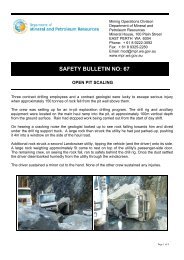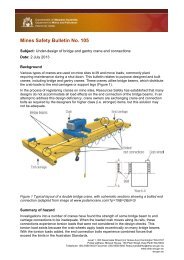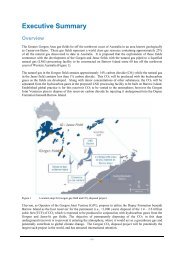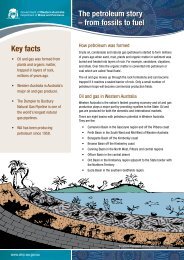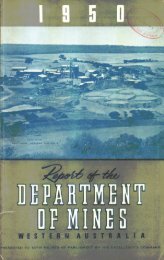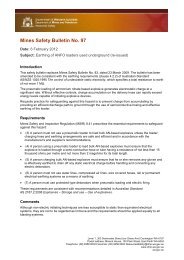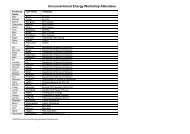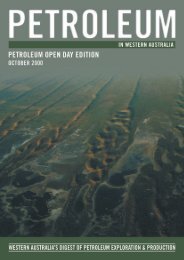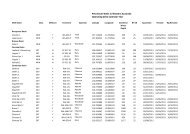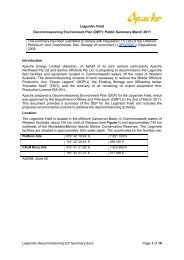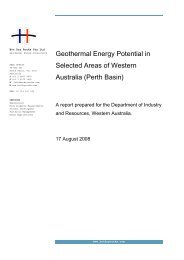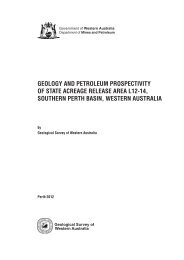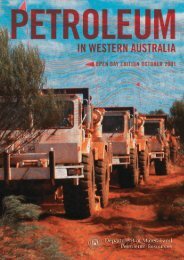IN WESTERN AUSTRALIA - Department of Mines and Petroleum
IN WESTERN AUSTRALIA - Department of Mines and Petroleum
IN WESTERN AUSTRALIA - Department of Mines and Petroleum
Create successful ePaper yourself
Turn your PDF publications into a flip-book with our unique Google optimized e-Paper software.
will be reached in the fourth quarter <strong>of</strong> 2004. At<br />
that time, the Buffalo Venture FPSO will be released,<br />
the existing wellbores will be ab<strong>and</strong>oned, <strong>and</strong> the<br />
wellhead platform will be recovered <strong>and</strong> towed away<br />
for onshore salvage.<br />
The safety <strong>and</strong> environmental performance <strong>of</strong> the<br />
entire Buffalo operation has been outst<strong>and</strong>ing. There<br />
were no lost time incidents or reportable<br />
environmental incidents during the 97-day drilling<br />
programme in 2002, some <strong>of</strong> which involved<br />
simultaneous activities (drilling, production,<br />
<strong>of</strong>floading <strong>and</strong> construction). The operations were a<br />
complex sequence <strong>of</strong> activities executed under the<br />
simultaneous operations (SIMOPS) constraints<br />
developed specifically for Buffalo <strong>and</strong> included in<br />
the Safety Case documentation. The Ocean Heritage<br />
drilling rig was also new to Australia <strong>and</strong> therefore<br />
required the development <strong>of</strong> a st<strong>and</strong>-alone Safety<br />
Case by the drilling contractor (Diamond Offshore<br />
Drilling, Inc.), <strong>and</strong> Bridging <strong>and</strong> SIMOPS documents,<br />
which were developed by Nexen. The operations<br />
also demonstrated Nexen’s commitment to protect<br />
the environment through the successful use <strong>of</strong> drill<br />
cuttings re-injection sub-sea, when possible, <strong>and</strong><br />
the use <strong>of</strong> a water based sodium silicate drilling<br />
fluid that reduced the impact <strong>of</strong> the remaining<br />
drilling cuttings on the sensitive Big Bank<br />
environment.<br />
Further to this, the Buffalo Venture FPSO achieved<br />
four years without an LTI (Lost Time Incident) on 29<br />
December 2003. This outst<strong>and</strong>ing safety record,<br />
which commenced at the start <strong>of</strong> production from the<br />
field in December 1999, has continued into 2004.<br />
Roc Oil<br />
The Cliff Head field, discovered in 2001 by ROC,<br />
was successfully appraised with the drilling <strong>of</strong> two<br />
wells in January <strong>and</strong> March 2003. Cliff Head 3 was<br />
sidetracked to core <strong>and</strong> was production tested at a<br />
stabilised rate, constrained by surface facilities, <strong>of</strong><br />
477 kL (3000 bbl) <strong>of</strong> oil per day via an 11 mm<br />
(28/64”) choke <strong>and</strong> a down hole electrical<br />
submersible pump. The second appraisal well, Cliff<br />
Head 4, was drilled <strong>and</strong> also cored for reservoir<br />
information.<br />
The EP413 JV conducted an extended production<br />
test on Jingemia 1 (drilled in October 2002) over<br />
the period May to August 2003, to determine the<br />
commerciality <strong>of</strong> the oil discovery <strong>and</strong> development<br />
strategy. During the test, rates in excess <strong>of</strong> 286<br />
kL/d (1800 bbl/d) were recorded.<br />
Jingemia 2 <strong>and</strong> its sidetrack Jingemia 3 were<br />
successfully drilled in August to September 2003,<br />
primarily to provide water injection for the field. A<br />
second extended production test was underway on<br />
Jingemia 1 at year-end.<br />
Detailed engineering <strong>and</strong> design work for the Cliff<br />
Head oil development was undertaken in 2003, <strong>and</strong><br />
ROC established an <strong>of</strong>fice in Perth to manage the<br />
project. On 14 October 2003, the Joint Venture took<br />
a major step towards commercial production with a<br />
unanimous declaration <strong>of</strong> commerciality <strong>and</strong><br />
agreement to move forward to the Front End<br />
Engineering <strong>and</strong> Design review stage (FEED). The<br />
FEED contract was awarded to Worley Pty Ltd. The<br />
decision to proceed towards FEED was based on a<br />
proved <strong>and</strong> probable reserve estimate <strong>of</strong> 3.3 GL (21<br />
MMbbl) <strong>of</strong> recoverable oil.<br />
The cost <strong>of</strong> the development is yet to be<br />
determined, but it is expected to be in the order <strong>of</strong><br />
$140 million, with a final decision on the investment<br />
expected in 2004. An application for the declaration<br />
<strong>of</strong> a location <strong>of</strong> one block was made over the Cliff<br />
Head field on 19 December 2003.<br />
A location <strong>of</strong> one graticular block over the Jingemia<br />
oilfield in EP413 was gazetted in January 2003, <strong>and</strong><br />
in July 2003, the JV made an application for a<br />
production licence.<br />
Work continues on progressing the Cliff Head oilfield<br />
towards commercial production. Subject to<br />
satisfactory completion <strong>of</strong> FEED <strong>and</strong> receipt <strong>of</strong><br />
regulatory <strong>and</strong> JV approvals, it is anticipated that a<br />
final investment decision for the project will be<br />
made during the second quarter <strong>of</strong> 2004 <strong>and</strong> that<br />
first oil will be produced from Cliff Head during the<br />
second half <strong>of</strong> 2005.<br />
Woodside Energy<br />
Development Activities 2003<br />
WA-271-P<br />
Development <strong>of</strong> the Enfield oilfield has progressed<br />
according to plan in 2003 with the project<br />
commencing the Front End Engineering Phase in<br />
May 2003. Contractors for the FPSO Hull, EPCm<br />
<strong>and</strong> Turret & Mooring facilities have been awarded.<br />
Environmental approval for the development was<br />
given by the Commonwealth Minister for<br />
Environment <strong>and</strong> Heritage in July. The development<br />
is planned to come on stream in late 2006 <strong>and</strong> will<br />
accommodate future area tie-backs such as<br />
Laverda as ullage becomes available.<br />
Following the disappointing appraisal result <strong>of</strong><br />
Laverda 2 (drilled in December 2002), Woodside<br />
participated in the drilling <strong>of</strong> Skiddaw 1 in May<br />
2003 in WA-255-P to appraise the northern extent<br />
<strong>of</strong> the Laverda field. Gas <strong>and</strong> oil columns were<br />
penetrated in Skiddaw 2 (a sidetrack to Skiddaw 1).<br />
Feasibility studies with respect to future<br />
development <strong>of</strong> the technically challenging Vincent<br />
field are continuing.<br />
WA-279-P<br />
Development <strong>of</strong> the Blacktip gasfield progressed<br />
into the concept selection phase in March 2003. In<br />
June 2003, the Blacktip JV signed a Heads <strong>of</strong><br />
Agreement with Alcan for the supply <strong>of</strong> gas to<br />
underpin Alcan’s planned expansion <strong>of</strong> its Gove<br />
alumina production <strong>and</strong> bauxite mining facilities.<br />
PWA April Edition - 2003 Review 19<br />
First gas is currently scheduled for January 2007.<br />
Following a further review in December, the Blacktip<br />
development will commence Basis <strong>of</strong> Design (BOD)<br />
studies in January 2004.<br />
Production Activities 2003<br />
Laminaria <strong>and</strong> Corallina<br />
In November 1999, the Northern Endeavour FPSO<br />
commenced production from the Laminaria <strong>and</strong><br />
Corallina fields in production licence AC/L5 located<br />
in the Timor Sea.<br />
The Laminaria <strong>and</strong> Corallina reservoirs have<br />
performed above expectation. The onset <strong>and</strong> rate <strong>of</strong><br />
increase in water production <strong>and</strong> the associated<br />
decline in productivity has been broadly in-line with<br />
reservoir model predictions. Total produced oil to the<br />
North end Rankin <strong>of</strong> June A platform 2003 was (image 24.13 courtesy GL. <strong>of</strong> Woodside)<br />
Legendre<br />
Development studies carried out in Q4, 2002<br />
resulted in an infill drilling opportunity to develop the<br />
poorly swept southwestern flank <strong>of</strong> the Legendre<br />
North field. The infill well, Legendre North 4H was<br />
drilled in April 2003 using the Ensco 56 <strong>and</strong><br />
commenced production on 10 June 2003.<br />
The performance <strong>of</strong> the Ocean Legend has been<br />
good with an annual average production rate <strong>of</strong><br />
4370 kL/d, with almost all gas re-injected <strong>and</strong><br />
minimal flaring. The maximum rate achieved during<br />
2003 followed the drilling <strong>of</strong> Legendre North 4H <strong>and</strong><br />
optimisation <strong>of</strong> gas h<strong>and</strong>ling facilities. Cumulative<br />
total produced oil to end 2003 was 4.429 GL.<br />
North Rankin<br />
The North Rankin gasfield lies 23 km northeast <strong>of</strong><br />
the Goodwyn field <strong>and</strong> approximately 140 km<br />
<strong>of</strong>fshore from Karratha in approximately 125 m <strong>of</strong><br />
water. The field was discovered in 1971 when the<br />
NRX-01 well penetrated 565 m <strong>of</strong> gross<br />
hydrocarbon column in Triassic, fluvio-estuarine<br />
reservoir quality s<strong>and</strong>s. The trap is structural,<br />
comprising a large horst block complex in the main<br />
body <strong>of</strong> the field with a zone <strong>of</strong> westerly dipping<br />
fault blocks in the northwest part <strong>of</strong> the field.<br />
Reservoir units gently dip northwards <strong>and</strong> sub-crop<br />
sealing Cretaceous shales over the crest <strong>of</strong> the<br />
field. At the northern end <strong>of</strong> the field, the top <strong>of</strong> the<br />
North Rankin reservoir is defined by depositionally<br />
conformable Triassic to Early Jurassic shales.<br />
During 2003, the field produced 3.79 Gm 3 <strong>of</strong> raw<br />
gas <strong>and</strong> 429 ML <strong>of</strong> condensate. During 2003/04,<br />
the NRA life extension <strong>and</strong> North Rankin ‘B’ platform<br />
will be studied to determine an optimum<br />
development infrastructure <strong>and</strong> functionality <strong>of</strong> the<br />
assets.<br />
Perseus<br />
The Perseus gasfield is located approximately 135<br />
km northwest <strong>of</strong> Karratha in 131 m water depth.<br />
The field lies in a graben bounded by the North<br />
Rankin field to the east <strong>and</strong> the Goodwyn field to<br />
the west.



